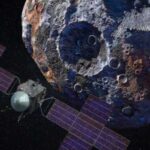James Webb Space Telescope Investigating Aliens After Finding Planet With ‘Signs of Life’
The post James Webb Space Telescope Investigating Aliens After Finding Planet With ‘Signs of Life’ appeared first on Healthy Holistic Living.
Has humanity just taken a monumental step closer to uncovering extraterrestrial life? The James Webb Space Telescope (JWST), a marvel of modern astronomy, has recently focused its powerful lens on a distant planet that shows tantalizing hints of life-supporting conditions. Situated hundreds of light-years away, this mysterious world, enveloped in a unique blend of gases, could rewrite our understanding of life in the cosmos. Join us as we explore the depths of space through the eyes of the JWST and edge closer to possibly the most profound discovery in human history.
The Discovery of K2-18b
K2-18b, an intriguing exoplanet, was first discovered in 2015 by astronomers using the Kepler Space Telescope during its extended K2 mission. This discovery marked a significant milestone in exoplanetary science due to the unique characteristics and potential habitability of K2-18b. The planet orbits the red dwarf star K2-18, located approximately 120 light-years away from Earth in the constellation Leo.
K2-18b stands out due to its size and composition. It is classified as a super-Earth or mini-Neptune because it is significantly larger than Earth but smaller than the typical gas giants found in our solar system. With a mass about 8.6 times that of Earth and a radius 2.6 times larger, K2-18b presents a fascinating case study for the study of planetary atmospheres and potential habitability.
The planet orbits its host star in the habitable zone, the region around a star where temperatures could allow for liquid water to exist on a planet’s surface. This orbital position and its atmospheric conditions make K2-18b a prime candidate for studying exoplanetary environments that might support life. The detection of water vapor in its atmosphere by subsequent observations using the Hubble Space Telescope has only heightened interest in K2-18b, suggesting that it might have conditions conducive to some form of life as we understand it.
Unusual Chemical Signatures on K2-18b
The exploration of K2-18b has revealed a compelling chemical signature in its atmosphere, characterized by the presence of methane (CH4), carbon dioxide (CO2), and notably, dimethyl sulfide (DMS). Each of these gases plays a critical role in the discussions about the potential for life on this distant world.
Methane and Carbon Dioxide
Both methane and carbon dioxide are common in the atmospheres of planets in our solar system, such as Earth and Mars. On Earth, methane can be produced both biologically, by organisms such as methanogenic archaea in the guts of animals and in wetlands, and abiotically through geological processes like serpentinization. The presence of methane on K2-18b raises the question of whether similar biological or geological processes could be occurring there. Carbon dioxide, a well-known greenhouse gas, is also crucial for its role in planetary temperature regulation and as a byproduct of both biological and geological activity.
Dimethyl Sulfide (DMS)
The detection of dimethyl sulfide is particularly significant because, on Earth, DMS is primarily produced by biological processes. It is most commonly associated with marine environments, where it is released by phytoplankton. DMS plays a role in the Earth’s climate system, contributing to cloud formation. The presence of DMS on K2-18b suggests that similar life processes involving complex organic compounds might be possible, if not likely. This molecule’s detection points to the potential for a biologically active environment, as it is not commonly expected to be produced in significant quantities through non-biological means.
The combination of these gases in K2-18b’s atmosphere not only suggests a chemically active environment but also opens the door to speculating about life processes. If the atmospheric conditions and chemical interactions on K2-18b parallel those on Earth, these gases could indicate the presence of a biosphere involving complex chemical and possibly biological interactions. However, further observations and analysis are required to understand the sources of these gases fully and to determine whether biological processes are a plausible explanation.
Hycean Exoplanets and the Possibility of Oceans
The concept of Hycean exoplanets introduces a fascinating category in the study of distant worlds. These are planets that are larger than Earth but smaller than Neptune and are characterized by thick hydrogen-rich atmospheres covering oceans that might span their entire surfaces. This category was proposed to broaden the criteria for habitability beyond the traditional Earth-like rocky planets.
Hycean planets are intriguing because of their potential to support liquid water under a wide range of atmospheric and thermal conditions. They typically orbit red dwarf stars, like K2-18b does, and can maintain stable temperatures conducive to liquid water despite their proximity to their host stars, primarily due to their dense atmospheres that efficiently trap heat.
The Hypothesis of Massive Oceans on K2-18b
In the case of K2-18b, the hypothesis that it might be a Hycean world stems from its size and the unique atmospheric findings. The planet’s significant radius and mass suggest an extensive ocean could exist beneath a thick atmosphere comprised mainly of hydrogen. This setup is similar to what scientists predict for Hycean planets, where massive oceans lie under high-pressure atmospheres rich in hydrogen, potentially creating conditions suitable for life as we know it.
The presence of methane and carbon dioxide, alongside the significant finding of dimethyl sulfide (DMS), supports the notion that K2-18b’s environment could be chemically dynamic and potentially hospitable. These conditions could allow for the kind of biochemical processes that occur in Earth’s own aquatic environments, perhaps even supporting life forms adapted to such exotic conditions.
The discussion about Hycean exoplanets and the example of K2-18b expands our understanding of habitability in the universe. It opens up a new realm of possibilities for life beyond the conventional scope of Earth-like planets, suggesting that life could exist in forms and under conditions that are vastly different from those on our planet.
The Role of JWST and NIRCam
The James Webb Space Telescope (JWST) represents a monumental advancement in space observation technology, equipped with tools specifically designed to study the universe with unprecedented clarity and depth. Among these tools, the Near-Infrared Camera (NIRCam) plays a pivotal role, especially in the exploration of exoplanets like K2-18b.
Technological Aspects of JWST
The JWST is equipped with a suite of instruments that allow it to perform a wide range of astronomical studies. It operates primarily in the infrared spectrum, which is essential for observing distant celestial objects whose light has been stretched into infrared wavelengths by the expansion of the universe. This capability is crucial for looking through cosmic dust and analyzing the chemical compositions of celestial bodies, which are often obscured in visible light.
The telescope’s large primary mirror, which spans 6.5 meters in diameter, collects light from these distant objects. This large size provides JWST with exceptional sensitivity, allowing it to detect faint signals from far-off galaxies and exoplanetary systems. The mirror’s design includes 18 hexagonal segments made from beryllium, a material chosen for its robustness and stability under extreme cold temperatures. This design enhances the telescope’s ability to focus on distant stars and their orbiting planets with extraordinary precision.
Role of NIRCam in Observing Exoplanets
NIRCam, as the primary imaging tool of JWST, is crucial in the hunt for exoplanets. It is equipped to perform wide-field and deep-space imaging and photometry in the near-infrared range. NIRCam’s capabilities are essential for detecting and analyzing the atmospheres of exoplanets. It observes the light passing through an exoplanet’s atmosphere as the planet transits in front of its host star. By examining changes in this light, scientists can infer the composition of the planet’s atmosphere — detecting elements and compounds like water vapor, methane, and even complex organic molecules such as dimethyl sulfide.
Moreover, NIRCam’s advanced optics are designed to reduce the blinding glare of the stars, enhancing its ability to detect the relatively dim lights of the planets orbiting around them. This function is vital for accurately determining the atmospheric characteristics of exoplanets, which can hint at their potential for supporting life.
In summary, the JWST, with its advanced instrument suite including NIRCam, significantly enhances our ability to study distant exoplanets. By providing detailed spectroscopic data and high-resolution imaging, these tools allow astronomers to probe the atmospheres of exoplanets, offering insights into their composition and conditions, which could indicate the presence of life-supporting environments.
The Scientific Process and Future Steps
Humanity’s Quest for Extraterrestrial Life: Why Are We So Cosmic-Curious?
The fascination with discovering life beyond Earth is deeply ingrained in human curiosity and represents one of the most profound quests of our time. The recent investigations by the James Webb Space Telescope (JWST) into planets displaying potential ‘signs of life’ underscores this relentless pursuit. There are several compelling reasons why humanity is eager to uncover extraterrestrial life:
Seeking Answers to Fundamental Questions: The search for life beyond Earth touches on some of the most fundamental questions about human existence: Are we alone in the universe? What is the nature of life? Finding life elsewhere would offer profound insights into these questions, potentially rewriting our understanding of life itself.
Understanding Our Own Planet: Studying life in other parts of the universe can provide critical insights into the evolution of life on Earth. By comparing terrestrial life with potential extraterrestrial organisms, scientists can better understand the conditions necessary for life and the various forms it might take, enhancing our knowledge of biology, evolution, and environmental science.
Technological Advancement: The pursuit of extraterrestrial life drives innovation and technological development. Instruments like the JWST are feats of engineering that not only aid in the search for life but also push the boundaries of what is technologically possible, leading to advancements that often have practical applications back on Earth.
Cultural and Philosophical Impact: Discovering extraterrestrial life would have significant cultural and philosophical implications. Such a discovery would challenge many existing human perspectives on religion, philosophy, and life’s purpose, prompting a profound reassessment of our place in the cosmos.
Future Survival and Exploration: Understanding if life can exist in environments different from our own could be crucial for the future survival and expansion of the human race. This knowledge might one day aid in colonizing other planets or utilizing extraterrestrial resources, helping humanity to become a multi-planetary species.
Uniting Humanity: The search for life beyond Earth is a global endeavor that transcends national borders, cultures, and conflicts. It is one of the few areas where international cooperation is both necessary and prevalent, illustrating how a shared, global interest can unite diverse groups of people.
The efforts by the James Webb Space Telescope to investigate potential signs of life on distant planets not only satisfy our innate curiosity but also hold the promise of answering age-old questions about existence, fostering international collaboration, and driving technological and scientific progress. This search connects us more deeply with the mysteries of the universe, continually reminding us of the vastness of the cosmos and our unique place within it.
Tips for Understanding Exoplanet Research
Exoplanet research might sound like it’s straight out of a science fiction novel, but it’s a real and exciting field of study that’s uncovering worlds beyond our solar system. Here are some simple, relatable tips to help everyone understand and get excited about this fascinating topic:
Catch the Basics with Simple Analogies: Think of exoplanet detection like a cosmic game of hide and seek. When a planet “hides” by passing in front of its star, it dims the star’s light just a bit, which telescopes can detect!
Get to Know the Neighborhood: The habitable zone is often called the “Goldilocks zone,” where conditions are just right—not too hot and cold—for water to possibly exist in liquid form, just like the porridge Goldilocks chose!
Follow Along with Space Missions: Keeping track of missions like NASA’s James Webb Space Telescope can be as easy as following a space-themed social media page or a blog that posts updates and cool space photos.
Visuals are Your Friend: Check out images and videos from space agencies. These often come with explanations that make the complex science behind exoplanets more understandable.
Join the Conversation: Find community events or online forums discussing space science. You don’t need to be an expert to participate; these platforms welcome curiosity!
Use Everyday Resources: Many websites and YouTube channels break down space topics in everyday language. Channels like NASA’s own YouTube page or popular science channels can demystify science with fun visuals and easy-to-understand commentary.
By using these tips, you’ll be able to not only follow but also enjoy the ongoing adventure of discovering new planets and possibly even signs of life beyond Earth. This is not just for scientists—it’s a journey we can all be part of!
The Dawn of a New Era in Exoplanetary Science
The James Webb Space Telescope’s exploration of K2-18b represents more than just a technological achievement; it signifies a monumental step forward in our quest to understand the universe and our place within it. The findings from JWST provide not only a glimpse into the atmospheric conditions of a distant exoplanet but also fuel the profound question of whether we are alone in the cosmos.
As we continue to monitor K2-18b and other similar celestial bodies, each piece of data enriches our knowledge and hones our scientific techniques, proving that the quest for extraterrestrial life is as much about the journey as it is about the destination. This ongoing research reminds us that the universe is full of mysteries waiting to be unraveled, and each discovery brings us closer to answering some of the most enigmatic questions about life and existence. As we look forward to the future of space exploration, the role of public engagement and understanding becomes crucial. By demystifying the complexities of space science, we invite more minds to wonder, inquire, and perhaps even contribute to one of humanity’s greatest adventures.
The post James Webb Space Telescope Investigating Aliens After Finding Planet With ‘Signs of Life’ appeared first on Healthy Holistic Living.
Related posts:
 Asteroid being captured by NASA worth $10,000,000,000,000,000,000 would make everyone on Earth a billionaire
Asteroid being captured by NASA worth $10,000,000,000,000,000,000 would make everyone on Earth a billionaire
 People Are Asking If There Is No Oxygen In Space, How Is The Sun On Fire?
People Are Asking If There Is No Oxygen In Space, How Is The Sun On Fire?
 Once-in-a-lifetime’ explosion so bright it’ll be visible from Earth could happen any time now
Once-in-a-lifetime’ explosion so bright it’ll be visible from Earth could happen any time now
 Elon Musk’s Starlink Satellites Are ‘Slowly Poisoning Us All’
Elon Musk’s Starlink Satellites Are ‘Slowly Poisoning Us All’
 Earth’s Expiry Date Revealed: NASA’s Revelation About Earth’s Fate
Earth’s Expiry Date Revealed: NASA’s Revelation About Earth’s Fate
Powered by YARPP.







